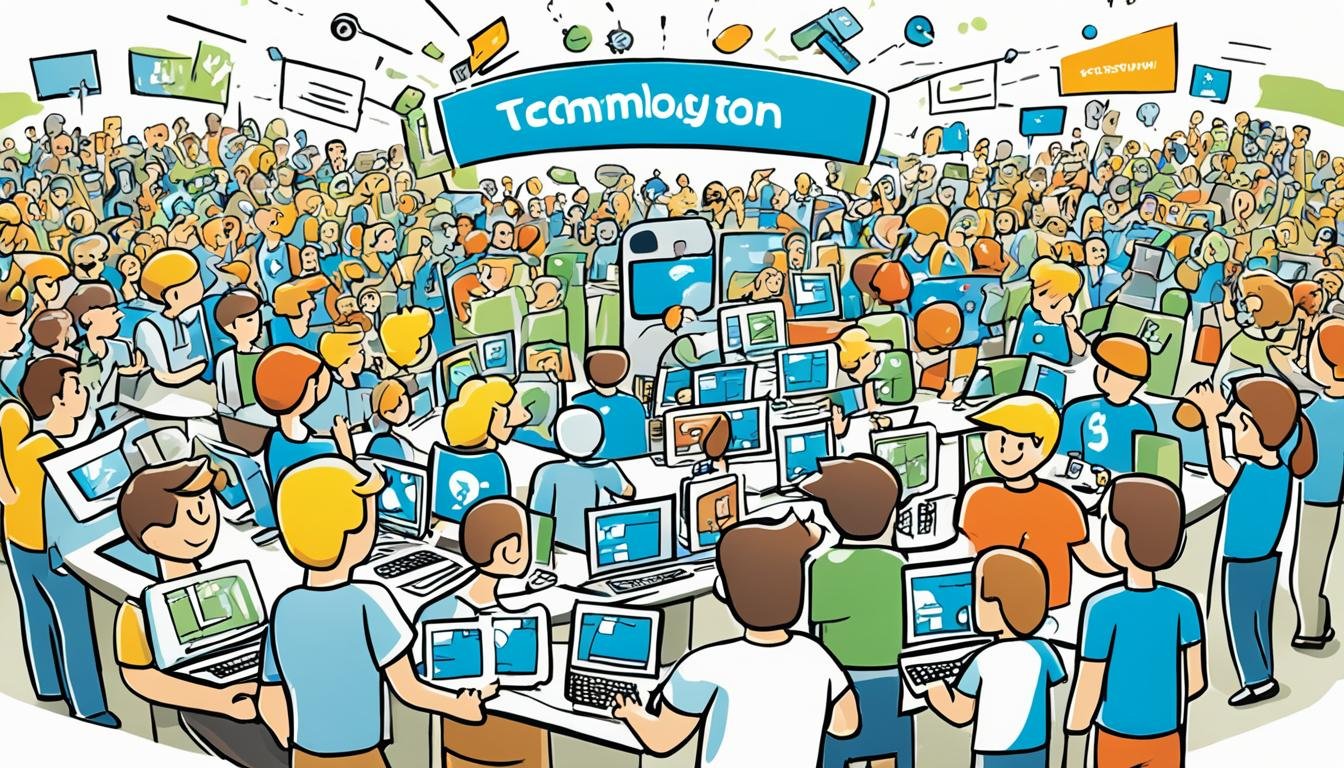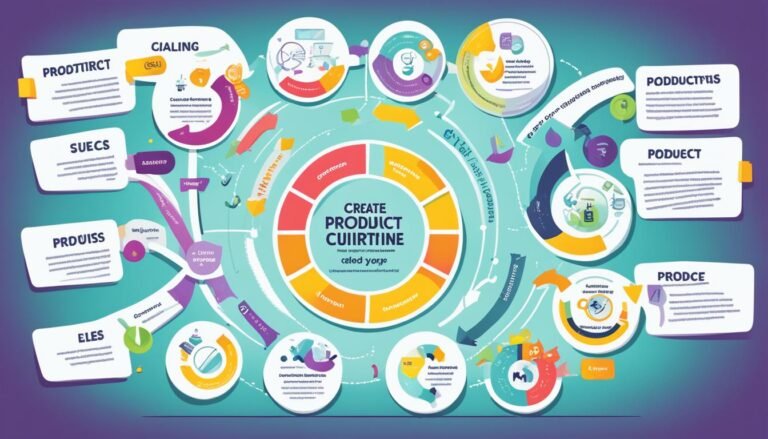The Diffusion of Innovation: Adopting New Technologies
Did you know that only 2.5% of people are innovators, the first to adopt new technology? This fact shows us the power of the diffusion of innovations. E.M. Rogers introduced this idea in his 1962 book, “The Diffusion of Innovations”. It explains how new technologies spread through society.
Rogers also talked about the technology adoption lifecycle. He divided people into five groups: innovators, early adopters, early majority, late majority, and laggards. Each group reacts differently to new ideas or products. Early adopters, making up 13.5% after innovators, help push new tech to more people.
The diffusion of innovations is powerful for predicting how new tech spreads. It helps in marketing and healthcare too. Knowing how new tech moves can change the game for businesses. The early and late majority, together, make up 68% of adopters. This shows how new tech slowly moves from a few to many people.
Key Takeaways
- Innovators make up a small but crucial 2.5% of early adopters in the diffusion of new technologies.
- Early adopters, representing 13.5%, significantly influence subsequent groups towards adopting new technologies.
- The early and late majority combined account for 68% of technology adopters, indicating the bulk of the population follows these groups.
- E.M. Rogers’ diffusion of innovations theory is a critical framework for understanding how new ideas and products spread.
- The adoption lifecycle follows a bell curve, highlighting different stages from slow initial uptake to widespread adoption.
Introduction to the Diffusion of Innovations Theory
E.M. Rogers created the Diffusion of Innovations Theory. It shows how new ideas and technologies spread in society. This theory explains how people adopt new technologies in different stages and social settings.
Defining Diffusion of Innovation
Innovation diffusion is about sharing new ideas over time in a social system. Rogers divided people into innovators, early adopters, early majority, late majority, and laggards. Knowing these groups helps plan how to bring new technologies to people.
Historical Background
Diffusion research started in rural sociology in the mid-20th century. It first helped spread new farming methods and tools. Then, it moved to fields like public health, education, and technology.
By the 1950s, researchers used what they knew to test how to spread innovations. This work has shaped how we study and influence the adoption of new technologies today.
Key Players in the Diffusion Process
The diffusion of innovations theory, created by E.M. Rogers in 1962, explains how new ideas spread. It talks about five groups: innovators, early adopters, early majority, late majority, and laggards. Knowing about these adopter categories helps us understand how new things move through a population.
Innovators
Innovators are the first to try new things. They love the excitement of being pioneers. They’re key because they make others aware of new ideas.
Early Adopters
Early Adopters are leaders in their communities. They quickly see the value in new ideas. Their support makes new things more credible and helps them spread.
Early Majority
Early Majority waits to try new things until they see it works for others. They look for proof of benefits before joining in. This careful approach helps new ideas become widely accepted.
Late Majority
Laggards are the last to adopt new ideas. They prefer traditional ways and are cautious about change. Their decision to adopt shows an innovation has reached the end of its lifecycle.
Laggards
Laggards are the last to adopt new ideas. They are set in their ways and wary of change. Factors like cost and risk can slow their adoption. When they finally accept an innovation, it marks the end of its spread.
Characteristics of Innovations Impacting Adoption
The success of new ideas depends on key traits. Knowing these innovation characteristics helps predict and boost adoption. These traits include relative advantage, compatibility, complexity, trialability, and observability.
Relative Advantage
Relative advantage means how much better a new idea is than old ones. In the 80s and early ’90s, computer programs like WordStar and WordPerfect were better than typewriters. This led many to switch.
Innovations that offer big benefits, like saving time or money, get adopted faster.
Compatibility
Compatibility checks if an idea fits with what people already value and do. Apple’s iPad was a hit because it fit easily into people’s lives. When an idea matches users’ values, it’s easier to adopt.
Complexity
Complexity is how hard an idea is to understand and use. The simpler an idea is, the faster it gets adopted. Easy-to-use interfaces and designs help people pick it up quicker.
Trialability
Trialability means trying out an idea before fully committing. Offering trial versions or demos lets users see the benefits. This reduces doubts and speeds up adoption. Trying a product first makes adopting it more likely.
Observability
Observability is seeing the good parts of an idea. Seeing the benefits makes more people want to try it. Good demos and positive feedback can make an idea more visible, leading to more adoption.
Success in making new ideas popular requires balancing these traits. Each trait affects how quickly and widely new technologies are taken up. By focusing on relative advantage, fitting in with what people already do, making it simple, offering trials, and making benefits clear, innovators can make their ideas more appealing. This leads to faster and wider adoption.
The Innovation Decision Process
The innovation decision process is a detailed model that shows how people decide to use new innovations. It has five main steps: learning about the innovation, forming an opinion, deciding to adopt or not, using the innovation, and confirming the choice.
Gaining knowledge is the first step where people learn about the innovation. This is key for what comes next. After learning, they form an opinion about it. They think about its good and bad points compared to what they already use.
Then, they make a big decision: to use or not to use the innovation. This choice is important because they think about its value, risks, and any negative views. If they decide to use it, they start to use it in real life.
Next, they confirm their decision. They look for support for their choice, checking how well it works and what others think. Each step can make them doubt, especially when deciding to use new technology. They might wonder if it’s better than what they already have, like spreadsheets or email.
How fast or slow people move through these steps can really differ. Some quickly take up new technologies, while others are more careful. This is seen in studies on STEM teachers and their use of new teaching methods. These studies show how adoption rates vary and the hurdles people face.
Knowing the innovation decision process helps us understand how customers might choose new products. It’s like Bob Moesta’s sales funnel timeline, showing a step-by-step process. This helps companies predict and overcome adoption barriers, making it easier for people to start using new technologies.
The Role of Change Agents and Opinion Leaders
Understanding the roles of change agents and opinion leaders is key in studying technology diffusion. These influencers push the adoption of new tech. They shape how new tech is seen and accepted in a community.
Change Agents Defined
Change agents are people who help clients make decisions about new ideas. They act as innovation champions, showing the good parts and getting people to support new tech. They make change happen and teach communities about the benefits of new tech.
Influence of Opinion Leaders
Opinion leaders are well-respected in their social circles. They have a big impact on how new tech spreads. By supporting new tech, they help it get adopted faster. Since they often try new things first, they set the trend for others to follow.
Diffusion Networks and Communication Channels
New ideas or technologies spread through networks and communication channels. Diffusion networks are key in sharing innovations. They connect people and systems, making information flow easier. These networks have social systems that help new technologies get adopted.
Role of Social Systems
Social systems are vital for sharing new ideas. They have social structures with different types of people, from innovators to laggards. Everett M. Rogers’ research highlights how social systems affect new tech adoption. The social capital in these systems helps or hinders the spread of new tech.
Importance of Communication Channels
Good communication channels help new ideas spread. They move information from one person or group to another, speeding up tech adoption. There are personal and mass media channels.
Personal channels, like word-of-mouth, build trust. Mass media, like ads and news, can reach more people fast. Using these channels wisely is key to making new tech successful.
Knowing how diffusion networks and communication channels work helps us improve tech adoption. By using strong social systems and various communication methods, we can make it easier for new innovations to spread and be accepted.
Factors Influencing the Rate of Adoption
The rate of adoption of new technologies can change a lot. Knowing what makes some innovations spread fast and others slow down is key. This helps us see why some tech takes off quickly while others don’t.
- Relative Advantage: When a new tech has a big advantage over the old one, like flash drives over CDs, it gets adopted faster. This makes people want it more.
- Compatibility: If a new tech fits well with what people already do, they take to it quicker. It’s easier to use and fits their lives better.
- Complexity: If a product is hard to understand or use, people might not adopt it. Things that are easy and straightforward get used more often.
- Trialability: Trying out a product before buying it helps people decide if they like it. Things that can be easily tried get used more by everyone.
- Observability: If the benefits of a product are easy to see, it gets adopted faster. People talk about what works well, helping others to join in.
Other things that affect adoption include social norms, if it makes sense financially, and rules that govern it. Personal and group reasons, fear of change, and being part of a community also matter a lot. These factors explain a big part of why some tech gets used more than others in certain groups.
How hard a product is promoted and the use of media and word of mouth can speed up or slow down its adoption. Knowing all these factors is important for making tech adoption successful.
Examples of Technology Adoption
Looking at technology adoption gives us a clear view of how new ideas spread in our world. We see this through the internet, social media, and medical innovations. These examples show how different groups of people have taken to new technologies over time.
The Internet
The internet’s spread is a prime example of how new tech gets adopted. It started with a few early users, then reached more people thanks to those who were quick to try new things. These early users were often young, had high social status, and were financially stable.
They made it easier for others to join in. The rest of society followed, making the internet a global network we use today.
Social Media Platforms
Social media is another great example of how tech adoption works. Sites like Facebook, Twitter, and Instagram first attracted those who loved staying connected and communicating quickly. These early users were key in making social media popular.
As more people joined, social media became a big part of our lives. Even the last groups to adopt it now use it every day, making it a huge part of our culture.
Medical Technologies
In the healthcare field, medical innovations show us how new tech gets used. Things like MRIs, telemedicine, and robotic surgeries started with a few pioneers. Early adopters, often doctors eager for new methods, helped spread these advances.
As more people, including the latecomers, started using these technologies, they became common in healthcare. This has led to better patient care and more efficient treatments.
The way these technologies were adopted follows a predictable pattern. It shows the five stages of technology adoption: innovators, early adopters, early majority, late majority, and laggards. This pattern confirms the Diffusion of Innovations Theory, showing how new tech moves through society.
Diffusion of Innovation in Marketing Strategies
Using the Diffusion of Innovation model helps businesses target different types of customers. This makes it easier for new products to enter the market. By knowing about five types of customers—Innovators, Early Adopters, Early Majority, Late Majority, and Laggards—marketers can make messages and strategies for each group.
Influencer Marketing
Influencer marketing uses the trust of Early Adopters, who are leaders in adopting new things. By working with influencers, brands can spread the word about new products. This can make more people aware of and accept the product faster.
Product Evangelism
Product evangelism is when customers love a product so much they tell others about it. These people share how great the product is, encouraging others to try it. Companies like Apple use this to spread the word about new products, making it a key part of their marketing.
Consumer Feedback Loops
Getting feedback from customers is key to making products better. By listening to what customers say, companies can improve their products. This makes the product more appealing to others and builds loyalty among customers.
Using feedback loops fits well with the Diffusion of Innovation model. It helps meet the needs of different customers, leading to more people adopting the product.
Source Links
- Diffusion of Innovation: How the Adoption of New Ideas Spreads | QAD Blog
- Diffusion of Innovations in Service Organizations: Systematic Review and Recommendations
- Applying Diffusion of Innovation Theory to Intervention Development
- The Diffusion of Innovations In K-12 Edtech
- Using Rogers’ diffusion of innovation theory to conceptualize the mobile-learning adoption process in teacher education in the COVID-19 era
- Diffusion of Innovations Theory: Definition and Examples
- Diffusion of Innovation Theory
- 5 Characteristics Of An Innovation
- 10.3 Diffusion of Innovation
- Empowering Innovation: How AI Drives Technology Adoption and Diffusion of Innovations | Role of AI in Technology Adoption and Diffusion of Innovation
- Innovation-Decision Model
- Product adoption is a process and a timeline (The Innovation-Decision Process)
- 9789712202599_content.pdf
- index
- Diffusion of innovations
- Microsoft Word – ED501453.doc
- NAB Show Guest Editorial | 2023 NAB Show
- Rogers Five Factors
- Factors influencing adoption | The Art of Business Planning
- The 5 Customer Segments of Technology Adoption
- Technology Adoption Curve: 5 Stages of Adoption | Whatfix
- The 5 Stages of the Technology Adoption Curve – Omniplex Guide
- What is the The Diffusion of Innovation model? | Smart Insights
- How The Diffusion of Innovation Can Inform Product Marketing







